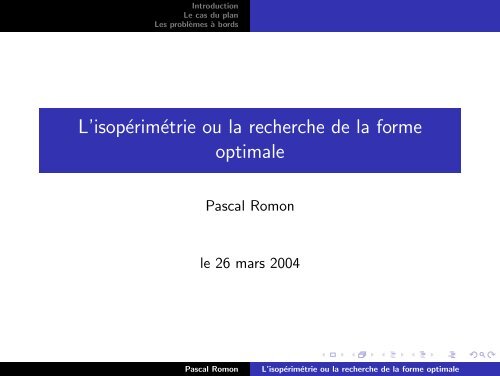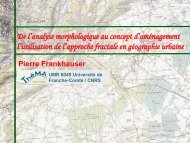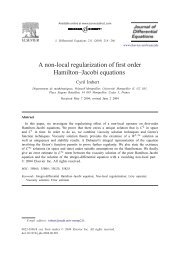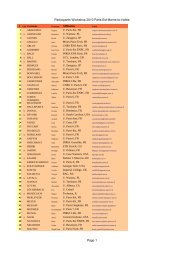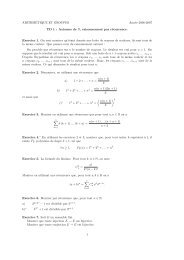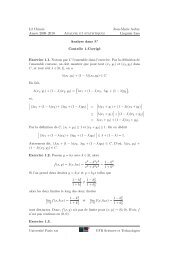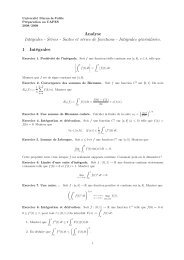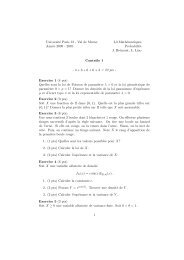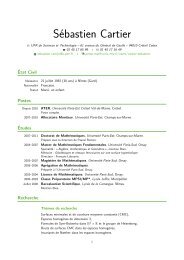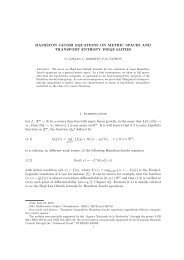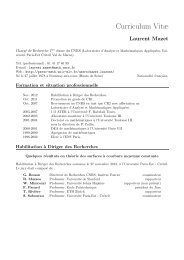L'isopérimétrie ou la recherche de la forme optimale
L'isopérimétrie ou la recherche de la forme optimale
L'isopérimétrie ou la recherche de la forme optimale
You also want an ePaper? Increase the reach of your titles
YUMPU automatically turns print PDFs into web optimized ePapers that Google loves.
Introduction<br />
Le cas du p<strong>la</strong>n<br />
Les problèmes à bords<br />
L’isopérimétrie <strong>ou</strong> <strong>la</strong> <strong>recherche</strong> <strong>de</strong> <strong>la</strong> <strong>forme</strong><br />
<strong>optimale</strong><br />
Pascal Romon<br />
le 26 mars 2004<br />
Pascal Romon L’isopérimétrie <strong>ou</strong> <strong>la</strong> <strong>recherche</strong> <strong>de</strong> <strong>la</strong> <strong>forme</strong> <strong>optimale</strong>
Introduction<br />
Le cas du p<strong>la</strong>n<br />
Les problèmes à bords<br />
Définition<br />
Qu’est-ce que le problème isopérimétrique ?<br />
Parmi les domaines du p<strong>la</strong>n <strong>de</strong> périmètre égal (iso–périmètre),<br />
tr<strong>ou</strong>ver celui qui bor<strong>de</strong> l’aire <strong>la</strong> plus gran<strong>de</strong> (problème <strong>de</strong> Didon).<br />
Existe-t-il ? Est-il unique ?<br />
Pascal Romon L’isopérimétrie <strong>ou</strong> <strong>la</strong> <strong>recherche</strong> <strong>de</strong> <strong>la</strong> <strong>forme</strong> <strong>optimale</strong>
Introduction<br />
Le cas du p<strong>la</strong>n<br />
Les problèmes à bords<br />
Définition<br />
Qu’est-ce que le problème isopérimétrique ?<br />
Parmi les domaines du p<strong>la</strong>n <strong>de</strong> périmètre égal (iso–périmètre),<br />
tr<strong>ou</strong>ver celui qui bor<strong>de</strong> l’aire <strong>la</strong> plus gran<strong>de</strong> (problème <strong>de</strong> Didon).<br />
Existe-t-il ? Est-il unique ?<br />
h<br />
2 b<br />
b<br />
Pascal Romon L’isopérimétrie <strong>ou</strong> <strong>la</strong> <strong>recherche</strong> <strong>de</strong> <strong>la</strong> <strong>forme</strong> <strong>optimale</strong><br />
c
Introduction<br />
Le cas du p<strong>la</strong>n<br />
Les problèmes à bords<br />
Définition<br />
Qu’est-ce que le problème isopérimétrique ?<br />
Parmi les domaines du p<strong>la</strong>n <strong>de</strong> périmètre égal (iso–périmètre),<br />
tr<strong>ou</strong>ver celui qui bor<strong>de</strong> l’aire <strong>la</strong> plus gran<strong>de</strong> (problème <strong>de</strong> Didon).<br />
Existe-t-il ? Est-il unique ?<br />
h<br />
2 b<br />
triangle rectangle carré<br />
A h 2 /2<br />
p h(2 + √ 2)<br />
A quand p = 4<br />
b<br />
Pascal Romon L’isopérimétrie <strong>ou</strong> <strong>la</strong> <strong>recherche</strong> <strong>de</strong> <strong>la</strong> <strong>forme</strong> <strong>optimale</strong><br />
c
Introduction<br />
Le cas du p<strong>la</strong>n<br />
Les problèmes à bords<br />
Définition<br />
Qu’est-ce que le problème isopérimétrique ?<br />
Parmi les domaines du p<strong>la</strong>n <strong>de</strong> périmètre égal (iso–périmètre),<br />
tr<strong>ou</strong>ver celui qui bor<strong>de</strong> l’aire <strong>la</strong> plus gran<strong>de</strong> (problème <strong>de</strong> Didon).<br />
Existe-t-il ? Est-il unique ?<br />
h<br />
2 b<br />
triangle rectangle carré<br />
A h 2 /2<br />
p h(2 + √ 2)<br />
A quand p = 4<br />
4<br />
3+2 √ 0, 69<br />
2<br />
b<br />
Pascal Romon L’isopérimétrie <strong>ou</strong> <strong>la</strong> <strong>recherche</strong> <strong>de</strong> <strong>la</strong> <strong>forme</strong> <strong>optimale</strong><br />
c
Introduction<br />
Le cas du p<strong>la</strong>n<br />
Les problèmes à bords<br />
Définition<br />
Qu’est-ce que le problème isopérimétrique ?<br />
Parmi les domaines du p<strong>la</strong>n <strong>de</strong> périmètre égal (iso–périmètre),<br />
tr<strong>ou</strong>ver celui qui bor<strong>de</strong> l’aire <strong>la</strong> plus gran<strong>de</strong> (problème <strong>de</strong> Didon).<br />
Existe-t-il ? Est-il unique ?<br />
h<br />
2 b<br />
triangle rectangle carré<br />
A h 2 /2 2b 2<br />
p h(2 + √ 2) 6b<br />
A quand p = 4<br />
4<br />
3+2 √ 0, 69<br />
2<br />
b<br />
Pascal Romon L’isopérimétrie <strong>ou</strong> <strong>la</strong> <strong>recherche</strong> <strong>de</strong> <strong>la</strong> <strong>forme</strong> <strong>optimale</strong><br />
c
Introduction<br />
Le cas du p<strong>la</strong>n<br />
Les problèmes à bords<br />
Définition<br />
Qu’est-ce que le problème isopérimétrique ?<br />
Parmi les domaines du p<strong>la</strong>n <strong>de</strong> périmètre égal (iso–périmètre),<br />
tr<strong>ou</strong>ver celui qui bor<strong>de</strong> l’aire <strong>la</strong> plus gran<strong>de</strong> (problème <strong>de</strong> Didon).<br />
Existe-t-il ? Est-il unique ?<br />
h<br />
2 b<br />
triangle rectangle carré<br />
A h 2 /2 2b 2<br />
p h(2 + √ 2) 6b<br />
A quand p = 4<br />
4<br />
3+2 √ 8 0, 69<br />
2<br />
b<br />
9 0, 89<br />
Pascal Romon L’isopérimétrie <strong>ou</strong> <strong>la</strong> <strong>recherche</strong> <strong>de</strong> <strong>la</strong> <strong>forme</strong> <strong>optimale</strong><br />
c
Introduction<br />
Le cas du p<strong>la</strong>n<br />
Les problèmes à bords<br />
Définition<br />
Qu’est-ce que le problème isopérimétrique ?<br />
Parmi les domaines du p<strong>la</strong>n <strong>de</strong> périmètre égal (iso–périmètre),<br />
tr<strong>ou</strong>ver celui qui bor<strong>de</strong> l’aire <strong>la</strong> plus gran<strong>de</strong> (problème <strong>de</strong> Didon).<br />
Existe-t-il ? Est-il unique ?<br />
h<br />
2 b<br />
triangle rectangle carré<br />
A h 2 /2 2b 2 c 2<br />
p h(2 + √ 2) 6b 4c<br />
A quand p = 4<br />
4<br />
3+2 √ 8 0, 69<br />
2<br />
b<br />
9 0, 89<br />
Pascal Romon L’isopérimétrie <strong>ou</strong> <strong>la</strong> <strong>recherche</strong> <strong>de</strong> <strong>la</strong> <strong>forme</strong> <strong>optimale</strong><br />
c
Introduction<br />
Le cas du p<strong>la</strong>n<br />
Les problèmes à bords<br />
Définition<br />
Qu’est-ce que le problème isopérimétrique ?<br />
Parmi les domaines du p<strong>la</strong>n <strong>de</strong> périmètre égal (iso–périmètre),<br />
tr<strong>ou</strong>ver celui qui bor<strong>de</strong> l’aire <strong>la</strong> plus gran<strong>de</strong> (problème <strong>de</strong> Didon).<br />
Existe-t-il ? Est-il unique ?<br />
h<br />
2 b<br />
triangle rectangle carré<br />
A h 2 /2 2b 2 c 2<br />
p h(2 + √ 2) 6b 4c<br />
A quand p = 4<br />
4<br />
3+2 √ 8 0, 69<br />
2<br />
b<br />
9 0, 89 1<br />
Pascal Romon L’isopérimétrie <strong>ou</strong> <strong>la</strong> <strong>recherche</strong> <strong>de</strong> <strong>la</strong> <strong>forme</strong> <strong>optimale</strong><br />
c
Introduction<br />
Le cas du p<strong>la</strong>n<br />
Les problèmes à bords<br />
Définition<br />
◮ Problème équivalent : quel est le domaine du p<strong>la</strong>n d’aire A<br />
fixée, ayant le périmètre p le plus petit possible ?<br />
Pascal Romon L’isopérimétrie <strong>ou</strong> <strong>la</strong> <strong>recherche</strong> <strong>de</strong> <strong>la</strong> <strong>forme</strong> <strong>optimale</strong>
Introduction<br />
Le cas du p<strong>la</strong>n<br />
Les problèmes à bords<br />
Définition<br />
◮ Problème équivalent : quel est le domaine du p<strong>la</strong>n d’aire A<br />
fixée, ayant le périmètre p le plus petit possible ?<br />
◮ Interprétation physique : quand on mé<strong>la</strong>nge <strong>de</strong>ux liqui<strong>de</strong>s (eau<br />
et huile, détergents), l’interface doit minimiser une énergie en<br />
général proportionnelle à <strong>la</strong> longueur (tension superficielle).<br />
Pascal Romon L’isopérimétrie <strong>ou</strong> <strong>la</strong> <strong>recherche</strong> <strong>de</strong> <strong>la</strong> <strong>forme</strong> <strong>optimale</strong>
Le cas du p<strong>la</strong>n<br />
Introduction<br />
Le cas du p<strong>la</strong>n<br />
Les problèmes à bords<br />
Une idée <strong>de</strong> démonstration<br />
Généralisations<br />
Dans le p<strong>la</strong>n, le domaine isopérimétrique est le disque, quelle que<br />
soit l’aire prescrite (<strong>ou</strong> le périmètre). Il existe un très grand nombre<br />
<strong>de</strong> démonstrations différentes <strong>de</strong> ce résultat. N<strong>ou</strong>s allons donner<br />
une idée <strong>de</strong> preuve en utilisant <strong>de</strong>s polygones.<br />
Pascal Romon L’isopérimétrie <strong>ou</strong> <strong>la</strong> <strong>recherche</strong> <strong>de</strong> <strong>la</strong> <strong>forme</strong> <strong>optimale</strong>
Introduction<br />
Le cas du p<strong>la</strong>n<br />
Les problèmes à bords<br />
Une idée <strong>de</strong> démonstration<br />
Généralisations<br />
Étape 1 : un polygone convexe est meilleur qu’un polygone<br />
concave.<br />
Pascal Romon L’isopérimétrie <strong>ou</strong> <strong>la</strong> <strong>recherche</strong> <strong>de</strong> <strong>la</strong> <strong>forme</strong> <strong>optimale</strong>
Introduction<br />
Le cas du p<strong>la</strong>n<br />
Les problèmes à bords<br />
Une idée <strong>de</strong> démonstration<br />
Généralisations<br />
Étape 1 : un polygone convexe est meilleur qu’un polygone<br />
concave.<br />
Pascal Romon L’isopérimétrie <strong>ou</strong> <strong>la</strong> <strong>recherche</strong> <strong>de</strong> <strong>la</strong> <strong>forme</strong> <strong>optimale</strong>
Introduction<br />
Le cas du p<strong>la</strong>n<br />
Les problèmes à bords<br />
Une idée <strong>de</strong> démonstration<br />
Généralisations<br />
Étape 1 : un polygone convexe est meilleur qu’un polygone<br />
concave.<br />
Pascal Romon L’isopérimétrie <strong>ou</strong> <strong>la</strong> <strong>recherche</strong> <strong>de</strong> <strong>la</strong> <strong>forme</strong> <strong>optimale</strong>
Introduction<br />
Le cas du p<strong>la</strong>n<br />
Les problèmes à bords<br />
Une idée <strong>de</strong> démonstration<br />
Généralisations<br />
Étape 1 : un polygone convexe est meilleur qu’un polygone<br />
concave.<br />
Pascal Romon L’isopérimétrie <strong>ou</strong> <strong>la</strong> <strong>recherche</strong> <strong>de</strong> <strong>la</strong> <strong>forme</strong> <strong>optimale</strong>
Introduction<br />
Le cas du p<strong>la</strong>n<br />
Les problèmes à bords<br />
Une idée <strong>de</strong> démonstration<br />
Généralisations<br />
Étape 1 : un polygone convexe est meilleur qu’un polygone<br />
concave.<br />
Pascal Romon L’isopérimétrie <strong>ou</strong> <strong>la</strong> <strong>recherche</strong> <strong>de</strong> <strong>la</strong> <strong>forme</strong> <strong>optimale</strong>
Introduction<br />
Le cas du p<strong>la</strong>n<br />
Les problèmes à bords<br />
Une idée <strong>de</strong> démonstration<br />
Généralisations<br />
Étape 2 : un polygone équi<strong>la</strong>tère est meilleur qu’un polygone aux<br />
côtés non égaux :<br />
Pascal Romon L’isopérimétrie <strong>ou</strong> <strong>la</strong> <strong>recherche</strong> <strong>de</strong> <strong>la</strong> <strong>forme</strong> <strong>optimale</strong>
Introduction<br />
Le cas du p<strong>la</strong>n<br />
Les problèmes à bords<br />
Une idée <strong>de</strong> démonstration<br />
Généralisations<br />
Étape 2 : un polygone équi<strong>la</strong>tère est meilleur qu’un polygone aux<br />
côtés non égaux :<br />
A<br />
Pascal Romon L’isopérimétrie <strong>ou</strong> <strong>la</strong> <strong>recherche</strong> <strong>de</strong> <strong>la</strong> <strong>forme</strong> <strong>optimale</strong><br />
B<br />
C
Introduction<br />
Le cas du p<strong>la</strong>n<br />
Les problèmes à bords<br />
Une idée <strong>de</strong> démonstration<br />
Généralisations<br />
Étape 2 : un polygone équi<strong>la</strong>tère est meilleur qu’un polygone aux<br />
côtés non égaux :<br />
A<br />
B’<br />
Pascal Romon L’isopérimétrie <strong>ou</strong> <strong>la</strong> <strong>recherche</strong> <strong>de</strong> <strong>la</strong> <strong>forme</strong> <strong>optimale</strong><br />
B<br />
C
Introduction<br />
Le cas du p<strong>la</strong>n<br />
Les problèmes à bords<br />
Une idée <strong>de</strong> démonstration<br />
Généralisations<br />
Étape 2 : un polygone équi<strong>la</strong>tère est meilleur qu’un polygone aux<br />
côtés non égaux : AB ′ + B ′ C ≤ AB + BC car (AB ′ C) est isocèle.<br />
A<br />
B’<br />
Pascal Romon L’isopérimétrie <strong>ou</strong> <strong>la</strong> <strong>recherche</strong> <strong>de</strong> <strong>la</strong> <strong>forme</strong> <strong>optimale</strong><br />
B<br />
C
Introduction<br />
Le cas du p<strong>la</strong>n<br />
Les problèmes à bords<br />
Une idée <strong>de</strong> démonstration<br />
Généralisations<br />
Étape 2 : un polygone équi<strong>la</strong>tère est meilleur qu’un polygone aux<br />
côtés non égaux : AB ′ + B ′ C ≤ AB + BC car (AB ′ C) est isocèle.<br />
A<br />
B’<br />
AB’ = CB’<br />
Pascal Romon L’isopérimétrie <strong>ou</strong> <strong>la</strong> <strong>recherche</strong> <strong>de</strong> <strong>la</strong> <strong>forme</strong> <strong>optimale</strong><br />
C
Introduction<br />
Le cas du p<strong>la</strong>n<br />
Les problèmes à bords<br />
Une idée <strong>de</strong> démonstration<br />
Généralisations<br />
Étape 3 : <strong>de</strong>s angles égaux augmentent l’aire.<br />
Pascal Romon L’isopérimétrie <strong>ou</strong> <strong>la</strong> <strong>recherche</strong> <strong>de</strong> <strong>la</strong> <strong>forme</strong> <strong>optimale</strong>
Introduction<br />
Le cas du p<strong>la</strong>n<br />
Les problèmes à bords<br />
Une idée <strong>de</strong> démonstration<br />
Généralisations<br />
Étape 3 : <strong>de</strong>s angles égaux augmentent l’aire. Si le polygone<br />
équi<strong>la</strong>tère possè<strong>de</strong> n côtés avec n pair, un diamètre PQ le sépare<br />
en <strong>de</strong>ux s<strong>ou</strong>s-polygones <strong>de</strong> même aire. Alors p<strong>ou</strong>r t<strong>ou</strong>t autre point<br />
R, (PQR) est rectangle en R, sinon on peut dé<strong>forme</strong>r.<br />
P<br />
R<br />
α<br />
Q P’<br />
Pascal Romon L’isopérimétrie <strong>ou</strong> <strong>la</strong> <strong>recherche</strong> <strong>de</strong> <strong>la</strong> <strong>forme</strong> <strong>optimale</strong><br />
R’<br />
Q’
Introduction<br />
Le cas du p<strong>la</strong>n<br />
Les problèmes à bords<br />
Une idée <strong>de</strong> démonstration<br />
Généralisations<br />
Étape 3 : <strong>de</strong>s angles égaux augmentent l’aire. Si le polygone<br />
équi<strong>la</strong>tère possè<strong>de</strong> n côtés avec n pair, un diamètre PQ le sépare<br />
en <strong>de</strong>ux s<strong>ou</strong>s-polygones <strong>de</strong> même aire. Alors p<strong>ou</strong>r t<strong>ou</strong>t autre point<br />
R, (PQR) est rectangle en R, sinon on peut dé<strong>forme</strong>r. En effet,<br />
PR = P ′ R ′ et QR = Q ′ R ′ , mais<br />
Aire(PQR) = 1<br />
2 PR QR sin α ≤ Aire(P′ Q ′ R ′ ).<br />
P<br />
R<br />
α<br />
Q P’<br />
Pascal Romon L’isopérimétrie <strong>ou</strong> <strong>la</strong> <strong>recherche</strong> <strong>de</strong> <strong>la</strong> <strong>forme</strong> <strong>optimale</strong><br />
R’<br />
Q’
Introduction<br />
Le cas du p<strong>la</strong>n<br />
Les problèmes à bords<br />
Une idée <strong>de</strong> démonstration<br />
Généralisations<br />
Étape 3 : <strong>de</strong>s angles égaux augmentent l’aire. Si le polygone<br />
équi<strong>la</strong>tère possè<strong>de</strong> n côtés avec n pair, un diamètre PQ le sépare<br />
en <strong>de</strong>ux s<strong>ou</strong>s-polygones <strong>de</strong> même aire. Alors p<strong>ou</strong>r t<strong>ou</strong>t autre point<br />
R, (PQR) est rectangle en R, sinon on peut dé<strong>forme</strong>r. En effet,<br />
PR = P ′ R ′ et QR = Q ′ R ′ , mais<br />
Aire(PQR) = 1<br />
2 PR QR sin α ≤ Aire(P′ Q ′ R ′ ).<br />
P<br />
R<br />
α<br />
Q P’<br />
Si n est impair on c<strong>ou</strong>pe chaque côté en <strong>de</strong>ux côtés égaux ...<br />
Pascal Romon L’isopérimétrie <strong>ou</strong> <strong>la</strong> <strong>recherche</strong> <strong>de</strong> <strong>la</strong> <strong>forme</strong> <strong>optimale</strong><br />
R’<br />
Q’
Introduction<br />
Le cas du p<strong>la</strong>n<br />
Les problèmes à bords<br />
Une idée <strong>de</strong> démonstration<br />
Généralisations<br />
Étape 4 : p<strong>ou</strong>r un polygone régulier (équi<strong>la</strong>tère à angles égaux),<br />
plus il y a <strong>de</strong> côtés, plus le périmètre est petit (à volume constant).<br />
Pascal Romon L’isopérimétrie <strong>ou</strong> <strong>la</strong> <strong>recherche</strong> <strong>de</strong> <strong>la</strong> <strong>forme</strong> <strong>optimale</strong>
Introduction<br />
Le cas du p<strong>la</strong>n<br />
Les problèmes à bords<br />
Une idée <strong>de</strong> démonstration<br />
Généralisations<br />
Étape 4 : p<strong>ou</strong>r un polygone régulier (équi<strong>la</strong>tère à angles égaux),<br />
plus il y a <strong>de</strong> côtés, plus le périmètre est petit (à volume constant).<br />
◮ Un polygone régulier à n côtés d’aire 1 a p<strong>ou</strong>r périmètre<br />
pn = 2 n tan π<br />
n .<br />
Pascal Romon L’isopérimétrie <strong>ou</strong> <strong>la</strong> <strong>recherche</strong> <strong>de</strong> <strong>la</strong> <strong>forme</strong> <strong>optimale</strong>
Introduction<br />
Le cas du p<strong>la</strong>n<br />
Les problèmes à bords<br />
Une idée <strong>de</strong> démonstration<br />
Généralisations<br />
Étape 4 : p<strong>ou</strong>r un polygone régulier (équi<strong>la</strong>tère à angles égaux),<br />
plus il y a <strong>de</strong> côtés, plus le périmètre est petit (à volume constant).<br />
◮ Un polygone régulier à n côtés d’aire 1 a p<strong>ou</strong>r périmètre<br />
pn = 2 n tan π<br />
n .<br />
◮ n ↦→ pn est décroissante avec n, et tend vers 2 √ π qui est le<br />
périmètre du cercle d’aire 1. Le cercle est d’ailleurs <strong>la</strong> limite<br />
<strong>de</strong>s polygones réguliers quand n tend vers l’infini.<br />
Pascal Romon L’isopérimétrie <strong>ou</strong> <strong>la</strong> <strong>recherche</strong> <strong>de</strong> <strong>la</strong> <strong>forme</strong> <strong>optimale</strong>
Introduction<br />
Le cas du p<strong>la</strong>n<br />
Les problèmes à bords<br />
Une idée <strong>de</strong> démonstration<br />
Généralisations<br />
Étape 4 : p<strong>ou</strong>r un polygone régulier (équi<strong>la</strong>tère à angles égaux),<br />
plus il y a <strong>de</strong> côtés, plus le périmètre est petit (à volume constant).<br />
◮ Un polygone régulier à n côtés d’aire 1 a p<strong>ou</strong>r périmètre<br />
pn = 2 n tan π<br />
n .<br />
◮ n ↦→ pn est décroissante avec n, et tend vers 2 √ π qui est le<br />
périmètre du cercle d’aire 1. Le cercle est d’ailleurs <strong>la</strong> limite<br />
<strong>de</strong>s polygones réguliers quand n tend vers l’infini.<br />
La démonstration est-elle complète ?<br />
Pascal Romon L’isopérimétrie <strong>ou</strong> <strong>la</strong> <strong>recherche</strong> <strong>de</strong> <strong>la</strong> <strong>forme</strong> <strong>optimale</strong>
Généralisations<br />
Introduction<br />
Le cas du p<strong>la</strong>n<br />
Les problèmes à bords<br />
Une idée <strong>de</strong> démonstration<br />
Généralisations<br />
Résultat fondamental [Almgren 1976] : dans une région bornée et<br />
p<strong>ou</strong>r t<strong>ou</strong>te aire, il existe t<strong>ou</strong>j<strong>ou</strong>rs un domaine isopérimétrique (non<br />
nécessairement unique) ; il est régulier (si <strong>la</strong> dimension ≤ 7). La<br />
géométrie locale <strong>de</strong>s solutions est en théorie bien comprise : il<br />
s’agit <strong>de</strong> c<strong>ou</strong>rbes (<strong>ou</strong> surfaces, etc) à c<strong>ou</strong>rbure constante. La<br />
géométrie globale est plus difficile.<br />
Pascal Romon L’isopérimétrie <strong>ou</strong> <strong>la</strong> <strong>recherche</strong> <strong>de</strong> <strong>la</strong> <strong>forme</strong> <strong>optimale</strong>
Introduction<br />
Le cas du p<strong>la</strong>n<br />
Les problèmes à bords<br />
Une idée <strong>de</strong> démonstration<br />
Généralisations<br />
Exemples <strong>de</strong> solutions isopérimétriques dans <strong>de</strong>s situations<br />
comparables.<br />
Pascal Romon L’isopérimétrie <strong>ou</strong> <strong>la</strong> <strong>recherche</strong> <strong>de</strong> <strong>la</strong> <strong>forme</strong> <strong>optimale</strong>
Introduction<br />
Le cas du p<strong>la</strong>n<br />
Les problèmes à bords<br />
Une idée <strong>de</strong> démonstration<br />
Généralisations<br />
Exemples <strong>de</strong> solutions isopérimétriques dans <strong>de</strong>s situations<br />
comparables.<br />
◮ Sur <strong>la</strong> sphère : calottes sphériques.<br />
Pascal Romon L’isopérimétrie <strong>ou</strong> <strong>la</strong> <strong>recherche</strong> <strong>de</strong> <strong>la</strong> <strong>forme</strong> <strong>optimale</strong>
Introduction<br />
Le cas du p<strong>la</strong>n<br />
Les problèmes à bords<br />
Une idée <strong>de</strong> démonstration<br />
Généralisations<br />
Exemples <strong>de</strong> solutions isopérimétriques dans <strong>de</strong>s situations<br />
comparables.<br />
◮ Sur <strong>la</strong> sphère : calottes sphériques.<br />
◮ Sur le cylindre : disques, puis cylindres<br />
<strong>de</strong> hauteur finie.<br />
Pascal Romon L’isopérimétrie <strong>ou</strong> <strong>la</strong> <strong>recherche</strong> <strong>de</strong> <strong>la</strong> <strong>forme</strong> <strong>optimale</strong>
Introduction<br />
Le cas du p<strong>la</strong>n<br />
Les problèmes à bords<br />
Une idée <strong>de</strong> démonstration<br />
Généralisations<br />
Exemples <strong>de</strong> solutions isopérimétriques dans <strong>de</strong>s situations<br />
comparables.<br />
◮ Sur <strong>la</strong> sphère : calottes sphériques.<br />
◮ Sur le cylindre : disques, puis cylindres<br />
<strong>de</strong> hauteur finie.<br />
◮ Sur le paraboloï<strong>de</strong> : calottes [résultat<br />
<strong>de</strong> 1996 !].<br />
Pascal Romon L’isopérimétrie <strong>ou</strong> <strong>la</strong> <strong>recherche</strong> <strong>de</strong> <strong>la</strong> <strong>forme</strong> <strong>optimale</strong>
Introduction<br />
Le cas du p<strong>la</strong>n<br />
Les problèmes à bords<br />
Une idée <strong>de</strong> démonstration<br />
Généralisations<br />
Exemples <strong>de</strong> solutions isopérimétriques dans <strong>de</strong>s situations<br />
comparables.<br />
◮ Sur <strong>la</strong> sphère : calottes sphériques.<br />
◮ Sur le cylindre : disques, puis cylindres<br />
<strong>de</strong> hauteur finie.<br />
◮ Sur le paraboloï<strong>de</strong> : calottes [résultat<br />
<strong>de</strong> 1996 !].<br />
◮ Dans l’espace (dimension 3 et plus) :<br />
b<strong>ou</strong>les ron<strong>de</strong>s.<br />
Pascal Romon L’isopérimétrie <strong>ou</strong> <strong>la</strong> <strong>recherche</strong> <strong>de</strong> <strong>la</strong> <strong>forme</strong> <strong>optimale</strong>
Introduction<br />
Le cas du p<strong>la</strong>n<br />
Les problèmes à bords<br />
Une idée <strong>de</strong> démonstration<br />
Généralisations<br />
Exemple sans solution du problème isopérimétrique : surface <strong>de</strong><br />
révolution.<br />
Pascal Romon L’isopérimétrie <strong>ou</strong> <strong>la</strong> <strong>recherche</strong> <strong>de</strong> <strong>la</strong> <strong>forme</strong> <strong>optimale</strong>
Les problèmes à bords<br />
Introduction<br />
Le cas du p<strong>la</strong>n<br />
Les problèmes à bords<br />
Définition et motivations<br />
Le cas du cube<br />
Les réseaux périodiques<br />
Il existe un problème analogue (dit problème à bords) : chercher le<br />
plus petit périmètre bord non compris p<strong>ou</strong>r une aire donnée.<br />
Pascal Romon L’isopérimétrie <strong>ou</strong> <strong>la</strong> <strong>recherche</strong> <strong>de</strong> <strong>la</strong> <strong>forme</strong> <strong>optimale</strong>
Les problèmes à bords<br />
Introduction<br />
Le cas du p<strong>la</strong>n<br />
Les problèmes à bords<br />
Définition et motivations<br />
Le cas du cube<br />
Les réseaux périodiques<br />
Il existe un problème analogue (dit problème à bords) : chercher le<br />
plus petit périmètre bord non compris p<strong>ou</strong>r une aire donnée.<br />
Cas du carré :<br />
Pascal Romon L’isopérimétrie <strong>ou</strong> <strong>la</strong> <strong>recherche</strong> <strong>de</strong> <strong>la</strong> <strong>forme</strong> <strong>optimale</strong>
Les problèmes à bords<br />
Introduction<br />
Le cas du p<strong>la</strong>n<br />
Les problèmes à bords<br />
Définition et motivations<br />
Le cas du cube<br />
Les réseaux périodiques<br />
Il existe un problème analogue (dit problème à bords) : chercher le<br />
plus petit périmètre bord non compris p<strong>ou</strong>r une aire donnée.<br />
Cas du carré :<br />
Les solutions dans le carré sont obtenus avec <strong>de</strong>s quarts <strong>de</strong> disque<br />
<strong>ou</strong> <strong>de</strong>s rectangles.<br />
Pascal Romon L’isopérimétrie <strong>ou</strong> <strong>la</strong> <strong>recherche</strong> <strong>de</strong> <strong>la</strong> <strong>forme</strong> <strong>optimale</strong>
Introduction<br />
Le cas du p<strong>la</strong>n<br />
Les problèmes à bords<br />
Définition et motivations<br />
Le cas du cube<br />
Les réseaux périodiques<br />
Application : inégalité isopérimétrique dans le carré (<strong>de</strong> côté 1).<br />
P<strong>ou</strong>r un domaine D, d’aire A et <strong>de</strong> périmètre p,<br />
p ≥ 4 A (1 − A)<br />
et l’égalité n’étant atteinte que p<strong>ou</strong>r un rectangle horizontal d’aire<br />
A = 1/2.<br />
Pascal Romon L’isopérimétrie <strong>ou</strong> <strong>la</strong> <strong>recherche</strong> <strong>de</strong> <strong>la</strong> <strong>forme</strong> <strong>optimale</strong>
Introduction<br />
Le cas du p<strong>la</strong>n<br />
Les problèmes à bords<br />
Définition et motivations<br />
Le cas du cube<br />
Les réseaux périodiques<br />
Corol<strong>la</strong>ire : le nombre <strong>de</strong> points à coordonnées entières contenus<br />
dans un convexe K est estimé à partir du périmètre p(K) et <strong>de</strong><br />
l’aire A(K) par<br />
N ≥ A(K) − 1<br />
p(K) .<br />
2<br />
Pascal Romon L’isopérimétrie <strong>ou</strong> <strong>la</strong> <strong>recherche</strong> <strong>de</strong> <strong>la</strong> <strong>forme</strong> <strong>optimale</strong>
Résultats généraux :<br />
Introduction<br />
Le cas du p<strong>la</strong>n<br />
Les problèmes à bords<br />
Définition et motivations<br />
Le cas du cube<br />
Les réseaux périodiques<br />
◮ il y a t<strong>ou</strong>j<strong>ou</strong>rs une solution (non nécessairement unique) ; elle<br />
est régulière (au moins jusqu’en dimension 7),<br />
◮ les c<strong>ou</strong>rbes solutions rencontrent perpendicu<strong>la</strong>irement le<br />
bord (quand elles le rencontrent).<br />
Pascal Romon L’isopérimétrie <strong>ou</strong> <strong>la</strong> <strong>recherche</strong> <strong>de</strong> <strong>la</strong> <strong>forme</strong> <strong>optimale</strong>
Introduction<br />
Le cas du p<strong>la</strong>n<br />
Les problèmes à bords<br />
Définition et motivations<br />
Le cas du cube<br />
Les réseaux périodiques<br />
Dans le cube, on minimise <strong>la</strong> surface à volume prescrit, et les<br />
solutions possibles sont (en fonction du volume) :<br />
Pascal Romon L’isopérimétrie <strong>ou</strong> <strong>la</strong> <strong>recherche</strong> <strong>de</strong> <strong>la</strong> <strong>forme</strong> <strong>optimale</strong>
Introduction<br />
Le cas du p<strong>la</strong>n<br />
Les problèmes à bords<br />
Définition et motivations<br />
Le cas du cube<br />
Les réseaux périodiques<br />
Dans le cube, on minimise <strong>la</strong> surface à volume prescrit, et les<br />
solutions possibles sont (en fonction du volume) :<br />
1/8 <strong>de</strong> sphère 1/4 <strong>de</strong> cylindre<br />
un carré<br />
Pascal Romon L’isopérimétrie <strong>ou</strong> <strong>la</strong> <strong>recherche</strong> <strong>de</strong> <strong>la</strong> <strong>forme</strong> <strong>optimale</strong>
Introduction<br />
Le cas du p<strong>la</strong>n<br />
Les problèmes à bords<br />
Définition et motivations<br />
Le cas du cube<br />
Les réseaux périodiques<br />
Dans le cube, on minimise <strong>la</strong> surface à volume prescrit, et les<br />
solutions possibles sont (en fonction du volume) :<br />
1/8 <strong>de</strong> sphère 1/4 <strong>de</strong> cylindre<br />
Lawson Schwarz<br />
un carré<br />
Pascal Romon L’isopérimétrie <strong>ou</strong> <strong>la</strong> <strong>recherche</strong> <strong>de</strong> <strong>la</strong> <strong>forme</strong> <strong>optimale</strong>
Introduction<br />
Le cas du p<strong>la</strong>n<br />
Les problèmes à bords<br />
Définition et motivations<br />
Le cas du cube<br />
Les réseaux périodiques<br />
À l’heure actuelle, on ne sait t<strong>ou</strong>j<strong>ou</strong>rs pas quelle est <strong>la</strong> solution<br />
isopérimétrique dans le cube, à volume donné. Mais on peut<br />
exclure t<strong>ou</strong>te autre solution que les 5 types précé<strong>de</strong>nts.<br />
Pascal Romon L’isopérimétrie <strong>ou</strong> <strong>la</strong> <strong>recherche</strong> <strong>de</strong> <strong>la</strong> <strong>forme</strong> <strong>optimale</strong>
Introduction<br />
Le cas du p<strong>la</strong>n<br />
Les problèmes à bords<br />
Définition et motivations<br />
Le cas du cube<br />
Les réseaux périodiques<br />
À l’heure actuelle, on ne sait t<strong>ou</strong>j<strong>ou</strong>rs pas quelle est <strong>la</strong> solution<br />
isopérimétrique dans le cube, à volume donné. Mais on peut<br />
exclure t<strong>ou</strong>te autre solution que les 5 types précé<strong>de</strong>nts.<br />
Demi-volume : <strong>la</strong> surface <strong>la</strong> plus petite séparant le cube en <strong>de</strong>ux<br />
volumes égaux est un carré parallèle à une <strong>de</strong> faces [Hadwiger<br />
1972].<br />
Pascal Romon L’isopérimétrie <strong>ou</strong> <strong>la</strong> <strong>recherche</strong> <strong>de</strong> <strong>la</strong> <strong>forme</strong> <strong>optimale</strong>
Introduction<br />
Le cas du p<strong>la</strong>n<br />
Les problèmes à bords<br />
Définition et motivations<br />
Le cas du cube<br />
Les réseaux périodiques<br />
À l’heure actuelle, on ne sait t<strong>ou</strong>j<strong>ou</strong>rs pas quelle est <strong>la</strong> solution<br />
isopérimétrique dans le cube, à volume donné. Mais on peut<br />
exclure t<strong>ou</strong>te autre solution que les 5 types précé<strong>de</strong>nts.<br />
Demi-volume : <strong>la</strong> surface <strong>la</strong> plus petite séparant le cube en <strong>de</strong>ux<br />
volumes égaux est un carré parallèle à une <strong>de</strong> faces [Hadwiger<br />
1972]. P<strong>ou</strong>r <strong>de</strong>s petits volumes, les morceaux <strong>de</strong> sphères sont<br />
optimaux.<br />
Pascal Romon L’isopérimétrie <strong>ou</strong> <strong>la</strong> <strong>recherche</strong> <strong>de</strong> <strong>la</strong> <strong>forme</strong> <strong>optimale</strong>
Introduction<br />
Le cas du p<strong>la</strong>n<br />
Les problèmes à bords<br />
Définition et motivations<br />
Le cas du cube<br />
Les réseaux périodiques<br />
À l’heure actuelle, on ne sait t<strong>ou</strong>j<strong>ou</strong>rs pas quelle est <strong>la</strong> solution<br />
isopérimétrique dans le cube, à volume donné. Mais on peut<br />
exclure t<strong>ou</strong>te autre solution que les 5 types précé<strong>de</strong>nts.<br />
Demi-volume : <strong>la</strong> surface <strong>la</strong> plus petite séparant le cube en <strong>de</strong>ux<br />
volumes égaux est un carré parallèle à une <strong>de</strong> faces [Hadwiger<br />
1972]. P<strong>ou</strong>r <strong>de</strong>s petits volumes, les morceaux <strong>de</strong> sphères sont<br />
optimaux. Conjecture : les surfaces isopérimétriques dans le cube<br />
sont <strong>de</strong>s morceaux <strong>de</strong> sphères, <strong>de</strong> cylindres <strong>ou</strong> <strong>de</strong> p<strong>la</strong>ns (ce qui<br />
exclut les surfaces <strong>de</strong> type Lawson <strong>ou</strong> Schwarz).<br />
Pascal Romon L’isopérimétrie <strong>ou</strong> <strong>la</strong> <strong>recherche</strong> <strong>de</strong> <strong>la</strong> <strong>forme</strong> <strong>optimale</strong>
Introduction<br />
Le cas du p<strong>la</strong>n<br />
Les problèmes à bords<br />
Définition et motivations<br />
Le cas du cube<br />
Les réseaux périodiques<br />
Interprétation physique et milieux périodiques<br />
Il est naturel <strong>de</strong> s’intéresser aux motifs répétitifs :<br />
Pascal Romon L’isopérimétrie <strong>ou</strong> <strong>la</strong> <strong>recherche</strong> <strong>de</strong> <strong>la</strong> <strong>forme</strong> <strong>optimale</strong>
Introduction<br />
Le cas du p<strong>la</strong>n<br />
Les problèmes à bords<br />
Définition et motivations<br />
Le cas du cube<br />
Les réseaux périodiques<br />
Interprétation physique et milieux périodiques<br />
Il est naturel <strong>de</strong> s’intéresser aux motifs répétitifs :<br />
◮ Solutions (mathématiques) périodiques dans l’espace p<strong>ou</strong>r le<br />
problème isopérimétrique,<br />
Pascal Romon L’isopérimétrie <strong>ou</strong> <strong>la</strong> <strong>recherche</strong> <strong>de</strong> <strong>la</strong> <strong>forme</strong> <strong>optimale</strong>
Introduction<br />
Le cas du p<strong>la</strong>n<br />
Les problèmes à bords<br />
Définition et motivations<br />
Le cas du cube<br />
Les réseaux périodiques<br />
Interprétation physique et milieux périodiques<br />
Il est naturel <strong>de</strong> s’intéresser aux motifs répétitifs :<br />
◮ Solutions (mathématiques) périodiques dans l’espace p<strong>ou</strong>r le<br />
problème isopérimétrique,<br />
◮ modélisation physico-chimique d’un milieu<br />
(approximativement) infini et/<strong>ou</strong> naturellement périodique<br />
(cristaux liqui<strong>de</strong>s).<br />
Pascal Romon L’isopérimétrie <strong>ou</strong> <strong>la</strong> <strong>recherche</strong> <strong>de</strong> <strong>la</strong> <strong>forme</strong> <strong>optimale</strong>
Introduction<br />
Le cas du p<strong>la</strong>n<br />
Les problèmes à bords<br />
Définition et motivations<br />
Le cas du cube<br />
Les réseaux périodiques<br />
Obtention <strong>de</strong> solutions périodiques à partir <strong>de</strong> solution du problème<br />
dans le cube (par réflexion) :<br />
Pascal Romon L’isopérimétrie <strong>ou</strong> <strong>la</strong> <strong>recherche</strong> <strong>de</strong> <strong>la</strong> <strong>forme</strong> <strong>optimale</strong>
Introduction<br />
Le cas du p<strong>la</strong>n<br />
Les problèmes à bords<br />
Définition et motivations<br />
Le cas du cube<br />
Les réseaux périodiques<br />
Obtention <strong>de</strong> solutions périodiques à partir <strong>de</strong> solution du problème<br />
dans le cube (par réflexion) : 1/8 <strong>de</strong> sphère<br />
Pascal Romon L’isopérimétrie <strong>ou</strong> <strong>la</strong> <strong>recherche</strong> <strong>de</strong> <strong>la</strong> <strong>forme</strong> <strong>optimale</strong>
Introduction<br />
Le cas du p<strong>la</strong>n<br />
Les problèmes à bords<br />
Définition et motivations<br />
Le cas du cube<br />
Les réseaux périodiques<br />
Obtention <strong>de</strong> solutions périodiques à partir <strong>de</strong> solution du problème<br />
dans le cube (par réflexion) : 1/4 <strong>de</strong> sphère<br />
Pascal Romon L’isopérimétrie <strong>ou</strong> <strong>la</strong> <strong>recherche</strong> <strong>de</strong> <strong>la</strong> <strong>forme</strong> <strong>optimale</strong>
Introduction<br />
Le cas du p<strong>la</strong>n<br />
Les problèmes à bords<br />
Définition et motivations<br />
Le cas du cube<br />
Les réseaux périodiques<br />
Obtention <strong>de</strong> solutions périodiques à partir <strong>de</strong> solution du problème<br />
dans le cube (par réflexion) : 1/2 sphère<br />
Pascal Romon L’isopérimétrie <strong>ou</strong> <strong>la</strong> <strong>recherche</strong> <strong>de</strong> <strong>la</strong> <strong>forme</strong> <strong>optimale</strong>
Introduction<br />
Le cas du p<strong>la</strong>n<br />
Les problèmes à bords<br />
Définition et motivations<br />
Le cas du cube<br />
Les réseaux périodiques<br />
Obtention <strong>de</strong> solutions périodiques à partir <strong>de</strong> solution du problème<br />
dans le cube (par réflexion) : 1 sphère<br />
Pascal Romon L’isopérimétrie <strong>ou</strong> <strong>la</strong> <strong>recherche</strong> <strong>de</strong> <strong>la</strong> <strong>forme</strong> <strong>optimale</strong>
Introduction<br />
Le cas du p<strong>la</strong>n<br />
Les problèmes à bords<br />
Définition et motivations<br />
Le cas du cube<br />
Les réseaux périodiques<br />
Obtention <strong>de</strong> solutions périodiques à partir <strong>de</strong> solution du problème<br />
dans le cube (par réflexion) : 2 sphères<br />
Pascal Romon L’isopérimétrie <strong>ou</strong> <strong>la</strong> <strong>recherche</strong> <strong>de</strong> <strong>la</strong> <strong>forme</strong> <strong>optimale</strong>
Introduction<br />
Le cas du p<strong>la</strong>n<br />
Les problèmes à bords<br />
Définition et motivations<br />
Le cas du cube<br />
Les réseaux périodiques<br />
Obtention <strong>de</strong> solutions périodiques à partir <strong>de</strong> solution du problème<br />
dans le cube (par réflexion) : 16 sphères<br />
Pascal Romon L’isopérimétrie <strong>ou</strong> <strong>la</strong> <strong>recherche</strong> <strong>de</strong> <strong>la</strong> <strong>forme</strong> <strong>optimale</strong>
Introduction<br />
Le cas du p<strong>la</strong>n<br />
Les problèmes à bords<br />
Définition et motivations<br />
Le cas du cube<br />
Les réseaux périodiques<br />
Exemple <strong>de</strong> partition dans un réseau périodique, selon le ratio <strong>de</strong><br />
<strong>de</strong>ux composants [Thomas].<br />
Pascal Romon L’isopérimétrie <strong>ou</strong> <strong>la</strong> <strong>recherche</strong> <strong>de</strong> <strong>la</strong> <strong>forme</strong> <strong>optimale</strong>
Références :<br />
Introduction<br />
Le cas du p<strong>la</strong>n<br />
Les problèmes à bords<br />
Définition et motivations<br />
Le cas du cube<br />
Les réseaux périodiques<br />
Almgren Existence and regu<strong>la</strong>rity almost everywhere of<br />
solutions to elliptic variational problems with<br />
constraints, Memoirs of the AMS 165.<br />
Howard, Hutchings & Morgan The isoperimetric problem on<br />
surfaces, American Mathematical Monthly, May<br />
1999.<br />
Thomas The Geometry of Intermaterial Dividing Surfaces in<br />
Block Copolymers<br />
http ://www.msri.org/publications/.<br />
Le Lorrain Didon montrant Carthage à Énée.<br />
Pascal Romon L’isopérimétrie <strong>ou</strong> <strong>la</strong> <strong>recherche</strong> <strong>de</strong> <strong>la</strong> <strong>forme</strong> <strong>optimale</strong>
Introduction<br />
Le cas du p<strong>la</strong>n<br />
Les problèmes à bords<br />
Définition et motivations<br />
Le cas du cube<br />
Les réseaux périodiques<br />
Compléments à <strong>la</strong> démonstration <strong>de</strong> l’isopérimétrie dans le p<strong>la</strong>n,<br />
via les polygones.<br />
◮ L’existence d’une solution n’est pas pr<strong>ou</strong>vée ! (ni p<strong>ou</strong>r les<br />
polygones, ni p<strong>ou</strong>r les cont<strong>ou</strong>rs en général).<br />
◮ Cas <strong>de</strong>s domaines non connexes.<br />
Ret<strong>ou</strong>r<br />
Pascal Romon L’isopérimétrie <strong>ou</strong> <strong>la</strong> <strong>recherche</strong> <strong>de</strong> <strong>la</strong> <strong>forme</strong> <strong>optimale</strong>
Introduction<br />
Le cas du p<strong>la</strong>n<br />
Les problèmes à bords<br />
Définition et motivations<br />
Le cas du cube<br />
Les réseaux périodiques<br />
Un triangle isocèle minimise le trajet AC passant par une droite<br />
parallèle à (AC).<br />
Pascal Romon L’isopérimétrie <strong>ou</strong> <strong>la</strong> <strong>recherche</strong> <strong>de</strong> <strong>la</strong> <strong>forme</strong> <strong>optimale</strong>
Introduction<br />
Le cas du p<strong>la</strong>n<br />
Les problèmes à bords<br />
Définition et motivations<br />
Le cas du cube<br />
Les réseaux périodiques<br />
n triangle isocèle minimise le trajet AC passant par une droite<br />
parallèle à (AC).<br />
A C<br />
B<br />
Pascal Romon L’isopérimétrie <strong>ou</strong> <strong>la</strong> <strong>recherche</strong> <strong>de</strong> <strong>la</strong> <strong>forme</strong> <strong>optimale</strong>
Introduction<br />
Le cas du p<strong>la</strong>n<br />
Les problèmes à bords<br />
Définition et motivations<br />
Le cas du cube<br />
Les réseaux périodiques<br />
n triangle isocèle minimise le trajet AC passant par une droite<br />
parallèle à (AC).<br />
En effet, BC = BC ′<br />
A C<br />
B<br />
Pascal Romon L’isopérimétrie <strong>ou</strong> <strong>la</strong> <strong>recherche</strong> <strong>de</strong> <strong>la</strong> <strong>forme</strong> <strong>optimale</strong><br />
C’
Introduction<br />
Le cas du p<strong>la</strong>n<br />
Les problèmes à bords<br />
Définition et motivations<br />
Le cas du cube<br />
Les réseaux périodiques<br />
n triangle isocèle minimise le trajet AC passant par une droite<br />
parallèle à (AC).<br />
En effet, BC = BC ′ et le trajet le plus c<strong>ou</strong>rt entre A et C ′ est <strong>la</strong><br />
ligne droite, passant par B ′ .<br />
Ret<strong>ou</strong>r<br />
B’<br />
A C<br />
B<br />
Pascal Romon L’isopérimétrie <strong>ou</strong> <strong>la</strong> <strong>recherche</strong> <strong>de</strong> <strong>la</strong> <strong>forme</strong> <strong>optimale</strong><br />
C’


